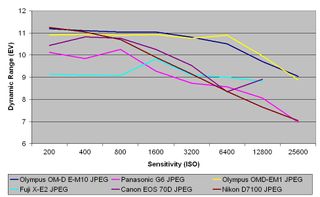Why you can trust TechRadar
We shoot a specially designed chart in carefully controlled conditions and the resulting images are analysed using DXO Analyzer software to generate the data to produce the graphs below.
A high signal to noise ratio (SNR) indicates a cleaner and better quality image.
For more more details on how to interpret our test data, check out our full explanation of our noise and dynamic range tests.
These charts compare the results of the Olympus OM-D E-M10 with the Panasonic G6, Olympus OM-D E-M1, Fuji X-E2, Canon 70D and Nikon D7100.
JPEG signal to noise ratio

Although the Panasonic G6 performs best at ISO 400, the Fuji X-E2 has the best results at every other sensitivity setting. This indicates that there's plenty of detail and low levels of noise in the X-E2's JPEG images in its default settings. However, the Olympus E-M10 puts in a very good performance and compares very well with the two SLRs (the Canon 70D and Nikon D7100), especially at the higher sensitivity settings.
Raw (after conversion to TIFF) signal to noise ratio

The Olympus E-M10 is a clear winner here, indicating that it produces the cleanest images across the sensitivity range. However, our resolution chart results show that this comes at the expense of some detail at the highest sensitivity values.
JPEG dynamic range

The Olympus E-M10 and E-M1 in their default (Natural) Picture Mode have very similar dynamic range in their JPEGs. This means that there's a wide range of tones and detail isn't lost quickly in the highlights or shadows. However, it's worth noting that the Fuji X-E2, which has a lower dynamic range, produces punchier-looking images straight from the camera in its default configuration.
Raw (after conversion to TIFF) dynamic range

These results confirm our real world findings that the Olympus E-M10's raw files have lots of tonal data and its images have an impressive dynamic range. It beats all the competing cameras here.
Current page: Noise and dynamic range
Prev Page Image quality and resolution Next Page Sample images
